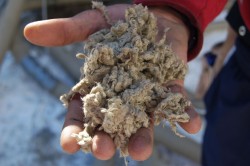Bio-based insulation materials facts & myths
1. Bio-based insulation materials could replace conventional materials in many cases without loss of thermal performance. It’s a fact. The heat insulation performance of bio-based insulation materials can compete with mineral or fossil-based materials, such as rock wool, glass wool and polystyrene. The technical performance of several renewable insulation materials, such as cellulose and fibres from hemp, flax, kenaf and cotton, is comparable to that of the mineral benchmarks. Also important is the ability of an insulation material to store heat and to release it to a cooler environment. This indicator is called specific heat capacity. Natural insulation materials can be superior to traditional fossil or mineral-based materials when it comes to heat buffering, because the specific heat capacity of natural insulation materials is higher than that of fossil or mineral-based ones. This can be helpful to create a more comfortable indoor climate and to prevent overheating of rooms that sit below the roof in the summer. 2. Bio-based insulation materials contribute to a pleasant and healthy indoor climate. It’s a fact. Insulation measures have caused the relative air humidity in many houses to be high, which can lead to growth of moulds. This is where bio-based materials can help. Scientific research has shown that most natural insulation materials can accumulate and conduct moisture. This moisture-regulating effect contributes to a balanced indoor climate throughout the year. This is especially important for people with respiratory diseases, asthma and atopic dermatitis, for which constant indoor humidity is very important. Sheep wool has an especially positive effect as it can absorb and neutralise a large variety of volatile organic compounds (VOCs) which can contribute to sick building syndrome. It acts as a passive air purifier. 3. Bio-based insulating materials cause mould problems. It’s a myth. Mould occurs in buildings whenever humidity cannot escape or humid air meets a cold surface. The type of surface plays only a minor role. If properly installed, bio-based insulating materials do not pose a higher risk of mould formation than traditional insulation materials. In fact, bio-based insulation materials have a good moisture-regulating effect. They can accumulate moisture up to one third of their weight and then release it again, which ensures a pleasant and healthy indoor climate. 4. Bio-based insulation materials are not really sustainable. It’s a myth. Natural insulating materials are ecologically high-quality products. Bio-based insulation contributes to energy saving and climate protection in three ways: • Firstly, renewable resources have the advantage of requiring much less energy than conventional building materials such as mineral wool and fossil-based materials to be produced. They typically have much lower “embodied energy” levels. • Secondly, natural insulation materials bind CO2 during the growth phase. Many natural insulating materials come from regional agriculture and forestry or can be obtained here in the future when demand increases. This means short transport distances, less import dependency and opportunities for rural areas. For many materials there is no conflict of use for other purposes. • Thirdly, using natural insulation reduces CO2 emissions through thermal insulation during the lifetime of buildings. The picture is differentiated when it comes to disposing of bio-based insulation materials. Some materials can be reused (cellulose flakes, seagrass), some can be recycled (hemp mats, sheep wool). In theory, a lot of these materials could be composted, but composting facilities are reluctant to accept them. Therefore, in most case bio-based insulation materials will be incinerated. Read more: http://www.allthings.bio/fact-or-myth/bio-based-insulation-materials-facts-myths/(opens in new window)
Keywords
Countries
United Kingdom



